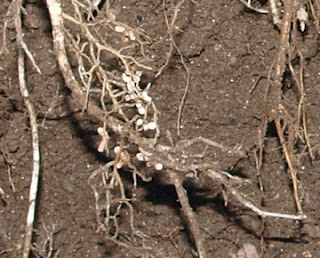Nitrogen fixing shubs are a basic element in forest gardening, as they provide a way to maintain (or increase) fertility without buying or importing anything. This makes so much sense that I think every gardener should use them and not just in a forest garden. The idea is simple enough, you just plant them in any unused patch of ground and leave them to take care of themselves. They will produce an annual crop of nitrogen rich leaves which can be used for mulch or compost material. You can also prune or coppice the plants periodically and chip the branches for mulch or compost. The nitrogen also finds its way into the soil through root sloughing and mycorrhizal fungi
While planting nitrogen fixers is certainly worthwhile, it may not actually be necessary. Before you go out and buy some of these valuable plants, you should look at what is already growing on your site. Useful wild nitrogen fixing shrubs (and trees that can be coppiced to grow as shrubs) can be found in the Alnus (Alder), Betula (Birch), Ceanothus, Cercidium (Paloverde),Cytisus, Eleagnus, Lupinus, Myrica, Robinia and Shepherdia families (they aren’t all confined to the bean family either). Some of these may well be growing there already and you don’t want to be in the absurd position of removing large and vigorous native nitrogen fixers, so you can plants some spindly little exotic nitrogen fixing shrubs you just paid for!
One of the problems with too much theoretical paper gardening is that it can take you away from the real garden, so you miss seeing the wood because of all the trees. I know this from experience in my own garden. I read about the importance of adding nitrogen fixers and even bought and planted some Black Locust and Siberian Pea shrub, before I really looked at everything that was already growing there. One common shrub (the particularly spiny and vigorous Coast Whitethorn (Ceanothus incanus) only attracted my attention because it would stab me every time I tried to interfere with it. In theory I knew Ceanothus species are nitrogen fixers, but this only came home to me when I had to dig one up and noticed the nitrogen fixing nodules on its’ roots. This transformed my relationship to the plant and I started to treat it as a legitimate member of my garden. This also brought home that we should take care of the native plants in our gardens and leave them alone where possible. A good rule is to never remove any native plant until you have identified it and determined its value.
Not too impressive as pictures, but here are those root nodules
Another useful nitrogen fixer in my garden is the exotic and invasive Scotch Broom. This is a serious weed in our area (in some places it’s everywhere) and for a long time I would methodically and meticulously uproot any seedlings that I saw in my garden. Even while I was trying to kill this plant, I couldn’t help being impressed by its’ tenacity. It has an astonishing ability to grow rapidly on poor soils and stay green through the heat and drought of summer with no apparent source of water at all. This winning combination of fast growth, drought tolerance and nitrogen fixing ability eventually made me re-evaluate the plant and decide that maybe nature was trying to tell me something. Instead of abusing it I started to use it as a source of compost or mulch material (it has the size, shape and density to go through my small electric shredder without any difficulty). I am still careful to keep it under strict control, so it doesn’t spread anywhere else.


No comments:
Post a Comment